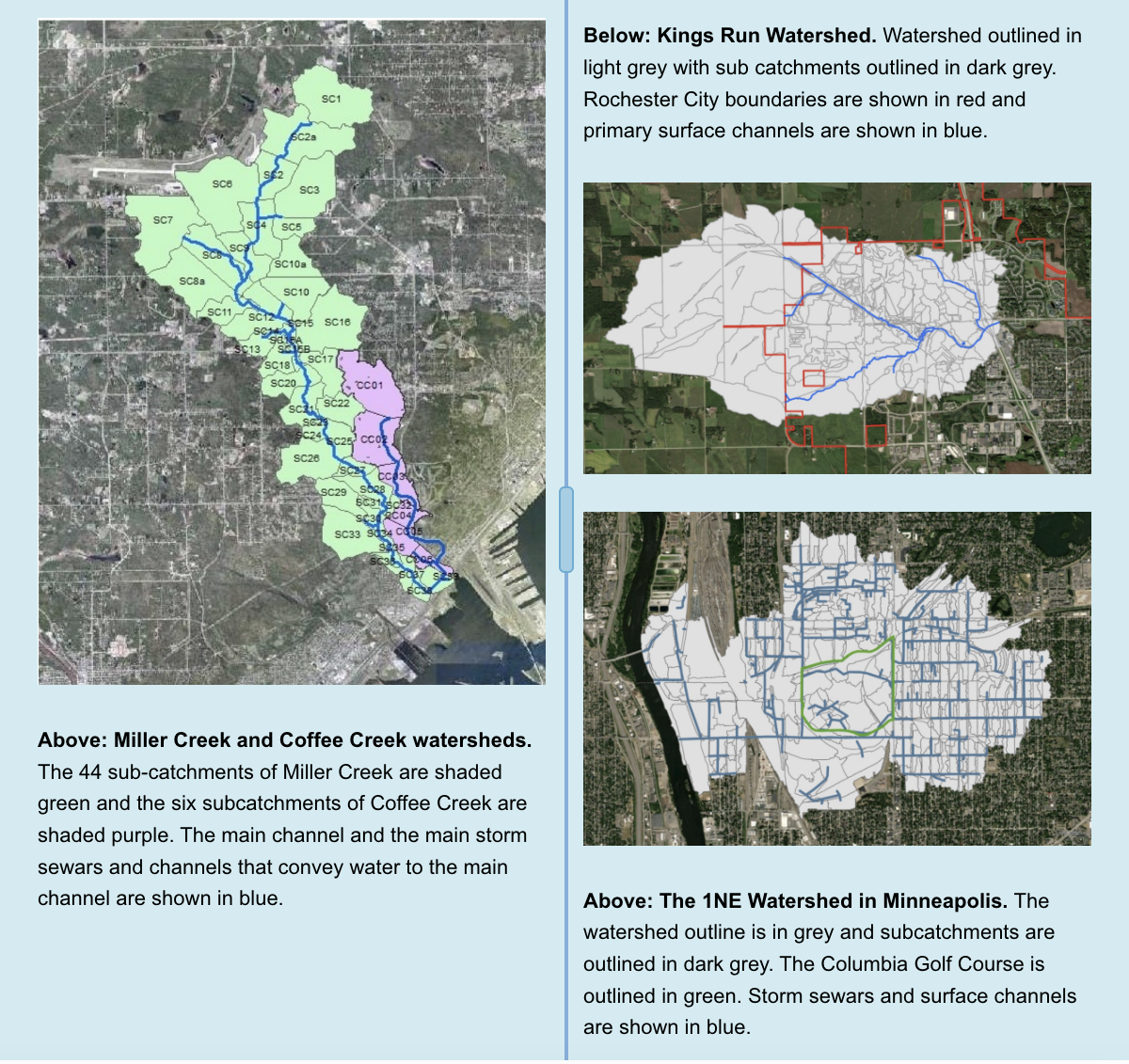
UPDATES: December 2023
Climate Change Adaptation of Urban Stormwater Infrastructure:
Three Case Studies of Stormwater Infrastructure in Minnesota Watersheds
UPDATES: December 2023 | Volume 18, Issue 1
Contributed by Bridget Mendel
What we did:
In June 2023, we released a report of interest to stormwater managers in Minnesota. Using past, present, and future climate model-based predictions, along with population growth predictions, we analyzed the current stormwater management infrastructure of three urban watersheds in Minnesota to see how they would hold up in future “peak flooding” events.
Our three in-depth case studies represent the diversity of land uses in Minnesota’s urban watersheds: the Miller Creek Watershed (Duluth), the Kings Run Watershed (Rochester), and the 1NE Watershed (Minneapolis). Our intention was not to develop specific adaptation plans for Minneapolis, Duluth, and Rochester, but to generate guidelines for Minnesota watersheds in general, as we face climate change together.

What we found:
Current stormwater infrastructure in all three cases was not sufficient to handle future flooding event predictions. We therefore analyzed the efficacy, feasibility, and cost of seven stormwater infrastructure adaptations that could be applied in order to handle “peak flooding:”
1.Baseline: "no modifications" are made.
2.Extra Ponds: new stormwater ponds are installed.
3. Infiltration Basins: rain gardens are installed
4. Smart ponds: existing ponds are retrofitted to be able to drain to half depth prior to storm events
5. More Smart Ponds: all new and existing ponds are made or retrofitted to be “smart.”
6. Pipe Upsizing: Existing storm sewer pipes are replaced with new larger pipes.
7. Underground Storage: subsurface vaults are installed to capture/ store stormwater.
In general, for all three watersheds, the order of most effective strategies for mitigating flooding during the MSE-3 design storm distributions is:
1) More Smart Ponds
2) Extra Ponds
3) Smart Ponds
4) Infiltration Basins
5) Baseline
6) Pipe Upsizing
7) Underground Storage
Considering cost, the order of strategies from least to most expensive is:
1) Baseline (maintenance of existing infrastructure)
2) Smart Ponds
3) Extra Ponds
4) Pipe Upsizing
5) More Smart Ponds
6) Infiltration Basins
7) Underground Storage
While each case study revealed distinct challenges based on land use and geography, we see an overall intersection of cost and efficacy here:
What you can do:
We hope the results of our analysis will be broadly useful for stormwater managers as they weigh the benefits of stormwater adaptations with realities of costs and feasibility.
While this analysis represents a snapshot in time, implementing these amendments at the scale proposed would likely require years if not decades of continuous adaptations as opportunities arise. We emphasize the opportunity to proactively incorporate stormwater infrastructure into future planned construction or urban planning. While the costs of proactive changes can be steep, the cost of future loss of life and property can be far more extensive. Explore each case study for details and analysis that could apply to your district.
Research and Funding: The full paper is authored by Andrew Erickson, William Herb, Noah Gallagher, Peter Weiss, Bruce Wilson, and John Gulliver at the UMN Saint Anthony Falls Lab, and sponsored by the Minnesota Local Road Research Board through the Minnesota Department of Transportation.
